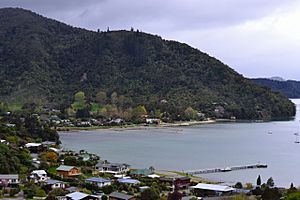Anakiwa facts for kids
Quick facts for kids
Anakiwa
|
|
|---|---|
|
Village
|
|

Anakiwa from the south-west, looking toward Outward Bound
|
|
| Country | New Zealand |
| Region | Marlborough |
| Ward |
|
| Electorates |
|
| Area | |
| • Total | 1.17 km2 (0.45 sq mi) |
| Population
(June 2023)
|
|
| • Total | 180 |
| • Density | 154/km2 (398/sq mi) |
| Postcode(s) |
7281
|
Anakiwa is a small village located right by the sea in the Marlborough region of New Zealand. It sits at the very top of Queen Charlotte Sound/Tōtaranui, which is one of the beautiful Marlborough Sounds. Anakiwa is about 23 kilometers (14 miles) west of Picton and 18 kilometers (11 miles) east of Havelock. In 2018, about 171 people lived here.
Anakiwa is also the end point of the famous Queen Charlotte Track. Many people who hike this track finish their journey here before taking a water taxi back to Picton.
Contents
History
Anakiwa's Early Days
Anakiwa has a long history as a Māori settlement. More recently, members of the Ngāti Rāhiri hapū (a smaller group within a tribe) of the Te Āti Awa iwi (tribe) lived here until 1859. They moved back to Taranaki, partly to join in the First Taranaki War. Before that, in earlier centuries, the Ngai Tara iwi also had influence in this area.
In 1839, Anakiwa was included in a land purchase by the New Zealand Company. However, it's thought that the Māori chiefs of the region might not have fully understood the document, or that it wasn't translated correctly.
The Beauchamp Family and Outward Bound
In 1864, the New Zealand Government gave land in Anakiwa to the Beauchamp family for farming. In 1928, the family built a guesthouse on their land. Later, this guesthouse was bought with money donated by Hamish Thomas. He wanted it to be the home for Outward Bound New Zealand. This special school, called "The Cobham Outward Bound School," was officially opened in 1962 by Governor-General Lord Cobham.
Local Landmarks
Within Anakiwa, there's a smaller area called Tirimoana. This was originally part of the farmland that surrounded the Outward Bound School.
Another spot is Boundary Gate Corner, which is about 3.25 kilometers (2 miles) from the main Queen Charlotte Drive. In the early 1900s, this marked the edge between two farms, and there used to be a gate across the road here. Today, you'll find a sign and a bench seat marking this historic spot.
People of Anakiwa
Population Overview
Anakiwa is considered a rural settlement by Statistics New Zealand. It covers about 1.17 square kilometers (0.45 square miles). In 2018, the village had a population of 171 people.
| Historical population for Anakiwa | ||
|---|---|---|
| Year | Pop. | ±% p.a. |
| 2006 | 183 | — |
| 2013 | 180 | −0.24% |
| 2018 | 171 | −1.02% |
At the 2018 New Zealand census, Anakiwa's population was 171. This was a small decrease from the 2013 and 2006 census numbers. There were 84 households. The population included 78 males and 93 females. The average age in Anakiwa was 58.4 years. About 5.3% of the people were under 15 years old, and 40.4% were 65 or older.
Ethnic Backgrounds and Beliefs
Most people in Anakiwa (96.5%) identified as European/Pākehā. About 7.0% identified as Māori. A small number of people identified with other ethnic groups, including Asian.
When asked about religion, 61.4% of people said they had no religion. About 29.8% were Christian.
Work and Education
For those aged 15 and older, about 27.8% had a university degree or higher. The average income was $24,700. Many people in Anakiwa were employed, with 40.7% working full-time and 14.8% working part-time.
Services
Boating and Access
Anakiwa is a great place for boating, with two public wharves and five public boat ramps along the waterfront. This makes it easy for people to launch their boats and enjoy the water.
Accommodation and Supplies
The village has many places to stay, including lodges, backpacker hostels, and bed & breakfast options. There's also a seasonal store that sells supplies. This store is very helpful for hikers finishing the Queen Charlotte Track and other visitors.
Public Facilities
You can find public toilets very close to the start of the Queen Charlotte Track. There's also a payphone in a small shelter nearby.
Nearby Services
For more services, you can visit the nearby Linkwater valley, which is about 7 kilometers (4 miles) away. In Linkwater, you'll find:
- A Challenge Petrol station and store
- A camping ground with cabins
- A motel
- A primary school
- A community hall
- A rural fire station

